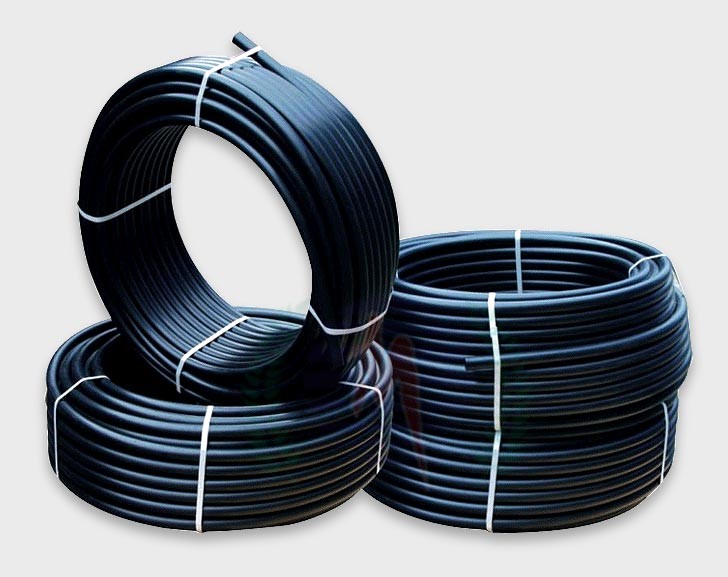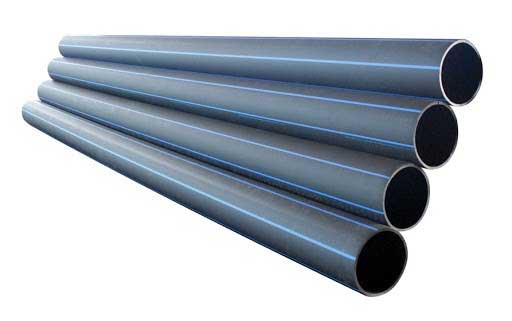How American Plastics HDPE Pipe Manufacturing Maintains High Standards
Wiki Article
Discover the Production Process Behind High-Quality HDPE Pipeline and Its Applications
The production process of high-quality HDPE pipelines is complex and methodical. It begins with the option of raw products that enhance efficiency. Following this, ethylene goes through polymerization to create resin, which is then formed via extrusion. Quality assurance is vital, making certain that the last product meets stringent requirements. Nonetheless, the journey of HDPE pipelines does not end with production. Their applications throughout different markets disclose a more comprehensive value worth examining.Comprehending HDPE: Properties and Advantages

High-density polyethylene (HDPE) is a flexible thermoplastic understood for its longevity and resistance to numerous ecological aspects. This material shows superb tensile toughness, making it appropriate for demanding applications. Its low-density structure adds to a light-weight item, facilitating ease of handling and installment. HDPE also showcases exceptional resistance to chemicals, which reduces deterioration when revealed to extreme materials.
The material's low moisture absorption better boosts its durability, making it excellent for usage in pipes and storage space containers. In addition, HDPE is immune to ultraviolet (UV) radiation, making sure that products keep their stability even when revealed to sunlight. In addition, its versatility permits the production of intricate shapes without compromising stamina. The green nature of HDPE, usually obtained from recycled materials, contributes to its charm, promoting lasting techniques in manufacturing. Generally, these residential or commercial properties and advantages make HDPE a recommended option for various industrial and consumer applications.
Resources Choice for HDPE Manufacturing
The choice of basic materials for HDPE production is vital to verify the last item fulfills the wanted specs and quality criteria. High-density polyethylene (HDPE) is largely generated from polymerized ethylene, originated from nonrenewable fuel sources such as gas or crude oil. The quality of these feedstocks substantially influences the mechanical and thermal residential properties of the last HDPE.Ingredients also play a considerable function in boosting HDPE's performance, including anti-oxidants, UV stabilizers, and colorants, which improve sturdiness and resistance to environmental aspects. The selection process need to think about not only the chemical make-up of the raw materials however additionally their processing characteristics to assure effective manufacturing.
Moreover, the sourcing of basic materials ought to focus on sustainability and compliance with ecological laws, as responsible practices are crucial in today's market. Eventually, mindful basic material choice lays the foundation for producing high-grade HDPE pipelines appropriate for varied applications.
The Extrusion Refine: Forming HDPE Pipe
The extrusion process plays a crucial duty in shaping HDPE pipes, starting with thorough product prep work strategies that guarantee optimal circulation and consistency. Equally essential is the design of the die, which directly influences the final measurements and surface area top quality of the pipeline. Together, these factors contribute substantially to the effectiveness and quality of HDPE pipe production.Product Prep Work Strategies
Efficient production of HDPE pipes begins with meticulous product prep work methods, specifically the extrusion process. Throughout this stage, high-density polyethylene resin is first dried to remove moisture, making sure optimal flow qualities. The resin is then fed into the extruder, where it goes through heating and melting, changing into a viscous state. This home heating procedure is very carefully regulated to preserve the material's integrity and efficiency. The molten HDPE is compelled through a die, shaping it into a continuous pipe form. Correct temperature administration during extrusion is crucial, as it directly influences the product's buildings and the final item top quality. Once formed, the HDPE pipeline is cooled down and reduced to specified lengths, ready for succeeding handling and applications.Die Layout Relevance
Accuracy in die design plays an important role in the extrusion procedure of HDPE pipes. The die works as the last shaping tool, directly influencing the pipeline's measurements, wall thickness, and surface coating. A well-designed die assurances consistent material flow, minimizing problems such as irregularities and weak points. The geometry of the die should be enhanced to suit the specific properties of HDPE, including its viscosity and thermal habits throughout extrusion. Furthermore, the cooling rate of the product as it goes through the die can considerably impact the pipeline's structural honesty. Investing in innovative die modern technology is crucial for producers aiming to create top notch HDPE pipelines that satisfy sector standards and client assumptions.Quality Assurance Procedures in HDPE Production
Different factors affect the quality of HDPE pipe manufacturing, effective high quality control steps are essential to guarantee uniformity and reliability in the last item (hdpe pipe fittings Midland TX). Trick high quality control methods include strenuous product inspection, confirming that the raw polyethylene satisfies recognized standards for pureness and thickness. During the extrusion process, criteria such as temperature level, pressure, and cooling time are very closely kept an eye on to keep dimensional precision and architectural stabilityFurthermore, post-production screening is crucial; makers frequently perform hydrostatic examinations to assess the pipe's strength and resistance to stress. Visual inspections for surface flaws additionally improve quality control. Certification from pertinent criteria organizations, like ASTM or ISO, supplies an extra layer of reliability. By applying these thorough quality control procedures, makers can reduce issues, boost efficiency, and ensure that the HDPE pipelines meet the certain demands of various applications, eventually leading to client satisfaction and trust fund in the product.
Applications of HDPE Pipe Throughout Industries
HDPE pipelines are utilized across numerous markets due to their toughness and versatility. In water circulation systems, they ensure reliable delivery, while in wastewater administration, they give reputable options for waste transportation. Furthermore, farming irrigation networks take advantage of HDPE's resistance to rust and adaptability, making it an optimal option for modern-day farming techniques.
Water Distribution Solutions
A significant variety of markets count on high-density polyethylene (HDPE) pipes for effective water circulation systems. Known for their longevity and resistance to corrosion, HDPE pipes are extensively utilized in metropolitan water networks, agricultural irrigation, and industrial applications. Their lightweight nature assists in very easy handling and installation, minimizing labor prices and time. Additionally, HDPE pipelines can fit various stress degrees, making them suitable for both reduced and high-pressure systems. Texas hdpe pipe manufacturer. The versatility of the product allows for smooth assimilation right into existing infrastructure, minimizing the requirement for considerable excavation. HDPE's resistance to chemical leaching warranties that the water delivered stays secure and clean, making it a suitable choice for preserving the top quality of drinkable water throughout various sectors.Wastewater Administration Solutions
Efficient water distribution systems also lead the way for cutting-edge wastewater management services, where high-density polyethylene (HDPE) pipes play a substantial role. Distinguished for their sturdiness and resistance to deterioration, HDPE pipelines are optimal for transferring wastewater in different setups. Their versatility permits easy setup in intricate settings, reducing the demand for extensive excavation. In addition, HDPE's smooth interior surface minimizes friction, boosting flow rates and effectiveness. These pipelines are also immune to chemical leaching, making sure that contaminants do not compromise the surrounding atmosphere. Industries, communities, and therapy centers significantly depend on HDPE pipes for their dependability and long life, making them a favored option for contemporary wastewater management systems. This adaptability emphasizes the critical significance of HDPE pipelines across numerous applications.Agricultural Watering Networks
Agricultural irrigation networks profit substantially from the usage of high-density polyethylene (HDPE) pipelines, which supply effective and reliable water shipment to plants. HDPE pipes are lightweight, making them simple to transfer and install, while their flexibility enables for various setups in diverse terrains. These pipelines demonstrate exceptional resistance to deterioration, chemicals, and UV radiation, making certain durability in extreme farming atmospheres. In addition, their smooth interior surface decreases friction loss, maximizing water flow and minimizing energy costs connected with pumping. The longevity of HDPE pipes, often surpassing half a century, adds to lower maintenance and replacement costs. Consequently, farmers increasingly depend on HDPE pipelines to improve irrigation effectiveness and promote sustainable farming practices, eventually resulting in improved plant yields and resource preservation.Future Fads in HDPE Pipeline Innovation
As the need for sustainable and reliable facilities grows, developments in HDPE pipe technology are poised to change different sectors. Arising trends include the assimilation of clever technologies, such as sensors and IoT capacities, which assist in real-time surveillance of pipeline problems, lowering maintenance expenses and avoiding leaks. Additionally, the growth of innovative production techniques, such as 3D printing, is allowing the manufacturing of complex, personalized pipeline designs that satisfy specific project requirements.The emphasis on recycling and round economic situation methods is driving the innovation of HDPE pipes made from recycled materials, enhancing sustainability. Improved jointing approaches, such as electro-fusion and mechanical fittings, are also enhancing installment effectiveness and dependability. The growing emphasis on ecological guidelines is pushing producers to take on greener manufacturing procedures, ensuring that HDPE pipelines not just fulfill industry requirements but additionally promote an even more sustainable future for facilities development.
Regularly Asked Inquiries
Exactly How Does HDPE Compare to Other Plastic Materials?
website HDPE outshines many various other plastic products relating to durability, chemical resistance, and adaptability. Its low density and high tensile stamina make it ideal for numerous applications, often surpassing alternatives in both efficiency and longevity.What Are the Environmental Impacts of HDPE Production?
The ecological effects of HDPE production consist of greenhouse gas exhausts, energy consumption, and possible air pollution from manufacturing processes. Furthermore, inappropriate disposal can result in dirt and water contamination, elevating problems about lasting eco-friendly results.Can HDPE Pipeline Be Recycled?
Yes, HDPE pipes can be reused. Lots of centers accept used HDPE for handling, changing it right into new products. This reusing adds to sustainability efforts, reducing plastic waste while saving sources and power in the production cycle.What Is the Life-span of HDPE Pipeline?

How Do Temperature Level Variations Impact HDPE Pipe Efficiency?
Temperature variations significantly impact HDPE pipe efficiency, influencing flexibility and stamina. High temperature levels can result in softening, while low temperature levels may create brittleness, ultimately influencing the pipe's durability and viability for various applications in diverse environments.Report this wiki page